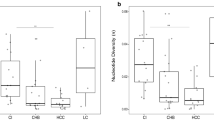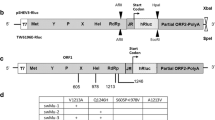Abstract
Background
Hepatitis B virus (HBV) X gene (HBx) mutants can develop during the natural course of chronic HBV infection. However, little is known about whether the emergence of HBx mutants during long-term antiviral therapy is an adaptation of HBV to antiviral stress. This study was to identify HBx mutants that emerged in patients experiencing Lamivudine resistance or suboptimal treatment.
Methods
Forty-six Lamivudine-resistant patients and 46 patients with suboptimal treatment responses to Entecavir were enrolled in this study. HBx mutants were identified by sequence analysis and their roles in the HBV replication cycle were characterized.
Results
We show that deletion/truncation/insertion mutations were only detected in the Lamivudine resistance group, while synonymous mutations were found in both groups. Follow-up analyses revealed that five patients in the Lamivudine group developed hepatocellular carcinoma, while patients in the Entecavir group did not. These mutants were characterized by a significant decrease in transactivation of the pre-S1 promoter, and varying effects on transactivation of the X promoter. Co-transfection of HBx-mutant plasmid and HBV replication-competent clone into HepG2 cells resulted in increased nuclear-to-cytoplamic HBV core antigen, HBV-DNA ratios, and nuclear covalently closed circular DNA (cccDNA). Antiviral drug sensitivity assays revealed that these mutants exhibited a compensatory effect to counteract antiviral drug suppression, resulting in elevated secretory HBV-DNA levels.
Conclusions
Our study demonstrates that HBx mutants can emerge during Lamivudine or Entecavir therapy. These mutants exhibit altered transactivation of the HBV pre-S1 and X promoters, leading to increased cccDNA levels to compensate for replication suppression.





Similar content being viewed by others
Abbreviations
- HBx:
-
Hepatitis B virus (HBV) X gene
- cccDNA:
-
Nuclear covalently closed circular DNA
- HBV:
-
Hepatitis B virus
- HCC:
-
Hepatocellular carcinoma
- LAM:
-
Lamivudine
- ETV:
-
Entecavir
- Ct-HBx:
-
C-terminally truncated HBx
- HBsAg:
-
Hepatitis B surface antigen
- PC:
-
Core promoter (PC)
- PS1:
-
Pre-S1 promoter
- PS2:
-
Pre-S2/S promoter
- PX:
-
X promoter
References
Terrault NA, Bzowej NH, Chang KM, Hwang JP, Jonas MM, Murad MH, et al. AASLD guidelines for treatment of chronic hepatitis B. Hepatology 2016;63(1):261–283
Sarin SK, Kumar M, Lau GK, Abbas Z, Chan HL, Chen CJ, et al. Asian-Pacific clinical practice guidelines on the management of hepatitis B: a 2015 update. Hepatol Int 2016;10(1):1–98
Lok AS, McMahon BJ, Brown RS Jr, Wong JB, Ahmed AT, Farah W, et al. Antiviral therapy for chronic hepatitis B viral infection in adults: a systematic review and meta-analysis. Hepatology 2016;63(1):284–306
European Association For The Study of the Liver. EASL clinical practice guidelines: management of chronic hepatitis B virus infection. J Hepatol 2012;57(1):167–185
Lin CL, Chien RN, Yeh C, Hsu CW, Chang ML, Chen YC, et al. Significant renoprotective effect of telbivudine during preemptive antiviral therapy in advanced liver cancer patients receiving cisplatin-based chemotherapy: a case-control study. Scand J Gastroenterol 2014;49(12):1456–1464
Lin CL, Chien RN, Hu CC, Lai MW, Yeh CT. Identification of hepatitis B virus rtS117F substitution as a compensatory mutation for rtM204I during lamivudine therapy. J Antimicrob Chemother 2012;67(1):39–48
Zoulim F, Locarnini S. Hepatitis B virus resistance to nucleos(t)ide analogues. Gastroenterology 2009;137(5):1593–1608.e1–2
Tenney DJ, Rose RE, Baldick CJ, Pokornowski KA, Eggers BJ, Fang J, et al. Long-term monitoring shows hepatitis B virus resistance to entecavir in nucleoside-naive patients is rare through 5 years of therapy. Hepatology 2009;49(5):1503–1514
Jeng WJ, Sheen IS, Chen YC, Hsu CW, Chien RN, Chu CM, et al. Off-therapy durability of response to entecavir therapy in hepatitis B e antigen-negative chronic hepatitis B patients. Hepatology. 2013;58(6):1888–1966
Tang H, Delgermaa L, Huang F, Oishi N, Liu L, He F, et al. The transcriptional transactivation function of HBx protein is important for its augmentation role in hepatitis B virus replication. J Virol 2005;79(9):5548–5556
van Hemert FJ, van de Klundert MA, Lukashov VV, Kootstra NA, Berkhout B, Zaaijer HL. Protein X of hepatitis B virus: origin and structure similarity with the central domain of DNA glycosylase. PLoS One 2011;6(8):e23392
Yeh CT, Shen CH, Tai DI, Chu CM, Liaw YF. Identification and characterization of a prevalent hepatitis B virus X protein mutant in Taiwanese patients with hepatocellular carcinoma. Oncogene 2000;19(46):5213–5220
Choi CS, Cho EY, Park R, Kim SJ, Cho JH, Kim HC. X gene mutations in hepatitis B patients with cirrhosis, with and without hepatocellular carcinoma. J Med Virol 2009;81(10):1721–1725
Lee JH, Han KH, Lee JM, Park JH, Kim HS. Impact of hepatitis B virus (HBV) X gene mutations on hepatocellular carcinoma development in chronic HBV infection. Clin Vaccine Immunol 2011;18(6):914–921
Zhang H, Shan CL, Li N, Zhang X, Zhang XZ, Xu FQ, et al. Identification of a natural mutant of HBV X protein truncated 27 amino acids at the COOH terminal and its effect on liver cell proliferation. Acta Pharmacol Sin 2008;29(4):473–480
Lucifora J, Arzberger S, Durantel D, Belloni L, Strubin M, Levrero M, et al. Hepatitis B virus X protein is essential to initiate and maintain virus replication after infection. J Hepatol 2011;55(5):996–1003
Ching RHH, Sze KMF, Lau EYT, Chiu YT, Lee JMF, Ng IOL, et al. C-terminal truncated hepatitis B virus X protein regulates tumorigenicity, self-renewal and drug resistance via STAT3/Nanog signaling pathway. Oncotarget 2017;8(14):23507–23516
Ng KY, Chai S, Tong M, Guan XY, Lin CH, Ching YP, et al. C-terminal truncated hepatitis B virus X protein promotes hepatocellular carcinogenesis through induction of cancer and stem cell-like properties. Oncotarget 2016;7(17):24005–24017
Gong DY, Chen EQ, Huang FJ, Leng XH, Cheng X, Tang H. Role and functional domain of hepatitis B virus X protein in regulating HBV transcription and replication in vitro and in vivo. Viruses 2013;5(5):1261–1271
Woo G, Tomlinson G, Nishikawa Y, Kowgier M, Sherman M, Wong DK, et al. Tenofovir and entecavir are the most effective antiviral agents for chronic hepatitis B: a systematic review and Bayesian meta-analyses. Gastroenterology 2010;139(4):1218–1229
Wong GL, Seto WK, Wong VW, Yuen MF, Chan HL. Review article: long-term safety of oral anti-viral treatment for chronic hepatitis B. Aliment Pharmacol Ther 2018;47(6):730–737
Sheldon J, Rodes B, Zoulim F, Bartholomeusz A, Soriano V. Mutations affecting the replication capacity of the hepatitis B virus. J Viral Hepat 2006;13(7):427–434
Muroyama R, Kato N, Yoshida H, Otsuka M, Moriyama M, Wang Y, et al. Nucleotide change of codon 38 in the X gene of hepatitis B virus genotype C is associated with an increased risk of hepatocellular carcinoma. J Hepatol 2006;45(6):805–812
Wang Q, Zhang T, Ye L, Wang W, Zhang X. Analysis of hepatitis B virus X gene (HBx) mutants in tissues of patients suffered from hepatocellular carcinoma in China. Cancer Epidemiol 2012;36(4):369–374
Minemura M, Shimizu Y, Hirano K, Nakayama Y, Tokimitsu Y, Tajiri K, et al. Functional analysis of transactivation by mutants of hepatitis B virus X gene in human hepatocellular carcinoma. Oncol Rep 2005;14(2):495–499
Shinkai N, Tanaka Y, Ito K, Mukaide M, Hasegawa I, Asahina Y, et al. Influence of hepatitis B virus X and core promoter mutations on hepatocellular carcinoma among patients infected with subgenotype C2. J Clin Microbiol 2007;45(10):3191–3197
Lin CL, Chu YD, Yeh CT. Emergence of oncogenic-enhancing hepatitis B virus X gene mutants in patients receiving suboptimal entecavir treatment. Hepatology 2019;69(5):2292–2296
Sze KM, Chu GK, Lee JM, Ng IO. C-terminal truncated hepatitis B virus X protein is associated with metastasis and enhances invasiveness by C-Jun/matrix metalloproteinase protein 10 activation in hepatocellular carcinoma. Hepatology 2013;57(1):131–139
Quetier I, Brezillon N, Revaud J, Ahodantin J, DaSilva L, Soussan P, et al. C-terminal-truncated hepatitis B virus X protein enhances the development of diethylnitrosamine-induced hepatocellular carcinogenesis. J Gen Virol 2015;96(Pt 3):614–625
Chen JY, Chen YJ, Yen CJ, Chen WS, Huang WC. HBx sensitizes hepatocellular carcinoma cells to lapatinib by up-regulating ErbB3. Oncotarget. 2016;7(1):473–89.
Acknowledgements
The authors appreciate the technical and administrative support provided by all members of the Liver Research Center in Chang Gung Memorial Hospital, Taoyuan, Taiwan.
Funding
This study was supported by grants from Chang Gung Memorial Hospital, Taiwan (CMRPG2B0463 and CRRPG2H0081).
Author information
Authors and Affiliations
Contributions
CTY designed and supervised the study; CLL, RNC and YDC drafted the manuscript; YDC, YHH, KHL and PYK performed the experiments; CTY, CLL, KHL, YHL interpreted the data; CTY, CLL, RNC and YDC collected and analyzed the clinical data.
Corresponding authors
Ethics declarations
Conflict of interest
No potential conflicts of interest were reported by the authors (Chih-Lang Lin, Rong-Nan Chien, Yu-De Chu, Kung-Hao Liang, Ya-Hui Huang, Po-Yuan Ke, Kwang-Huei Lin, Yang-Hsiang Lin, Chau-Ting Yeh).
Ethics approval statement
This study was approved by the Institutional Review Board of Chang Gung Medical Center. The experiments conformed to the ethical guidelines of the 1975 Declaration of Helsinki.
Informed consent
Informed consent was obtained from patients, prior to their participation in the study.
Additional information
Publisher's Note
Springer Nature remains neutral with regard to jurisdictional claims in published maps and institutional affiliations.
YHL and CTY are co-corresponding authors.
Electronic supplementary material
Below is the link to the electronic supplementary material.
Rights and permissions
About this article
Cite this article
Lin, CL., Chien, RN., Chu, YD. et al. Hepatitis B virus X gene mutants emerge during antiviral therapy and increase cccDNA levels to compensate for replication suppression. Hepatol Int 14, 973–984 (2020). https://doi.org/10.1007/s12072-020-10079-1
Received:
Accepted:
Published:
Issue Date:
DOI: https://doi.org/10.1007/s12072-020-10079-1




